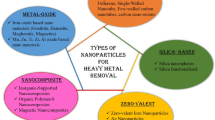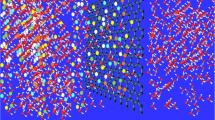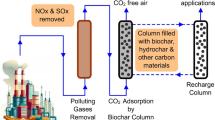Abstract
Floating catalytic chemical vapor deposition technique was used for synthesizing carbon nanotubes (CNTs) using ferrocene in benzene as the hydrocarbon source. The functionalization of CNTs was carried out by oxidation followed by grafting of potassium iodide (KI) and mercaptoethanol (HS(CH2)2OH) ligands to produce iodide-grafted CNTs (CNT-I) and thiol-functionalized CNTs (CNT-SH), respectively. The resulting adsorbents have been thoroughly characterized by various techniques. Fourier transform infrared (FTIR) spectroscopy and X-ray photoelectron spectroscopy (XPS) studies revealed the efficient grafting of the ligands. Further, their adsorption capacities towards antimonite have been assessed. The adsorption kinetics fitted the pseudo-second-order model for both the adsorbents. Moreover, the adsorption of Sb(III) followed Langmuir and Freundlich’s model. The maximum adsorption capacity of CNT-I and CNT-SH for Sb(III) at pH 7 was found to be 200 and 140.85 mg/g, respectively. The interference effect of various ions on the adsorption of antimonite was studied. A suitable mechanism for Sb(III) adsorption has been postulated using TEM, XRD, XPS, and FTIR. The adaptability of the adsorbents was demonstrated by the removal capacity of Sb(III) at parts per billion levels from nuclear decontamination formulation (NAC) and tap water matrix as well.











Similar content being viewed by others
References
Biskup B, Subotic B (2005) Removal of heavy metal ions from solutions using zeolites. III Influence of sodium ion concentration in the liquid phase on the kinetics of exchange processes between cadmium ions from solution and sodium ions from zeolite A. Sep Sci Technol 39:925–940
Biswas BK, Inoue JI, Kawakita H, Ohto K, Inoue K (2009) Effective removal and recovery of antimony using metal-loaded saponified orange waste. J Hazard Mater 172:721–728
Chmielewska E, Tylus W, Drabik M, Majzlan J, Kravcak J, Williams C, Caplovicova M, Caplovic L (2017) Structure investigation of nano-FeO(OH) modified clinoptilolite tuff for antimony removal. Micropor Mesopor Mater 248:222–233
Chong ASM, Zhao XS (2003) Functionalization of SBA-15 with APTES and characterization of functionalized materials. J Phys Chem B 107:12650–12657
Dominguez L, Yue Z, Economy J, Mangun CL (2002) Design of polyvinyl alcohol mercaptylfibers for arsenite chelation. React Funct Polym 53:205–215
EU Directive 98/83/EC (1998) Council directive of 3 November 1998 on the quality of water intended for human consumption. Off J Eur Union
Fan HT, Sun Y, Tang Q, Li WL, Sun T (2014) Selective adsorption of antimony(III) from aqueous solution by ion-imprinted organic–inorganic hybrid sorbent: kinetics, isotherms and thermodynamics. J Taiwan Inst Chem Eng 45:2640–2648
Fan HT, Sun W, Jiang B, Wang QJ, Li DW, Huang CC, Wang KJ, Zhang ZG, Li WX (2016) Adsorption of antimony(III) from aqueous solution by mercapto functionalized silica-supported organic-inorganic hybrid sorbent: mechanism insights. Chem Eng J 286:128–138
Farahmandjou M, Soflaee F (2014) Low temperature synthesis of α-Fe2O3nano-rods using simple chemical route. J Nanostruct 4:413–418
Filella M, Belzile N, Chen Y-W (2002a) Antimony in the environment: a review focused on natural waters: I. Occurrence. Earth-Sci Rev 57:125–176
Filella M, Belzile N, Chen YW (2002b) Antimony in the environment: a review focused on natural waters: II. Relevant solution chemistry. Earth Sci Rev 59:265–285
Gobbo P, Biesinger MC, Workentin MS (2013) Facile synthesis of gold nanoparticle (AuNP)- carbonnanotubes (CNT) hybrids through an interfacial Michael addition reaction. Chem Commun 49:2831–2833
Gupta A, Vidyarthi SR, Sankararamakrishnan N (2014) Enhanced sorption of mercury from compact fluorescent bulbs and contaminated water streams using functionalized multiwalled carbon nanotubes. J Hazard Mater 274:132–144
Han L, Sun H, Ro KS, Sun K, Libra JA, Xing B (2017) Removal of antimony (III) and cadmium (II) from aqueous solution using animal manure-derived hydrochars and pyrochars. Bioresour Technol 234:77–85
He Z, Liu R, Liu H, Qu J (2015) Adsorption of Sb(III) and Sb(V) on freshly prepared ferric hydroxide (FeOxHy). Environ Eng Sci 32:95–102
Ho YS (2006) Review of second-order models for adsorption systems. J Hazard Mater 136:681–689
Lagergren S (1898) Zurtheorie der sogenannten absorption gelosterStoffe, KungligaSvenskaVetenskapsakademiens. Hand 24:1–39
Lan B, Wang Y, Wang X, Zhou X, Kang Y, Li L (2016) Aqueous arsenic (As) and antimony (Sb) removal by potassium ferrate. Chem Eng J 292:389–397
Leng Y, Guo W, Su S, Yi C, Xing L (2012) Removal of antimony (III) from aqueous solution by graphene as an adsorbent. Chem Eng J 211-212:406–411
Li X, Dou X, Li J (2012) Antimony (V) removal from water by iron-zirconium bimetal oxide: performance and mechanism. J Environ Sci 24:1197–1203
Lindsay WL (1979) Chemical equilibria in soils. Wiley, New York
Liu A, Liu J, Pan B, Zhang WX (2014) Formation of lepidocrocite from oxidation of nanoscalezerovalent iron (nZVI) in oxygenated water. RSC Adv 4:57377–57382
Luo J, Luo X, Crittenden J, Qu J, Bai Y, Peng Y, Li J (2015) Removal of Antimonite (Sb(III)) and Antimonate (Sb(V)) from aqueous solution using carbon Nanofibers that are decorated with zirconium oxide (ZrO2).Env Sci and Technol 49:11115–111124
Mishra S, Dwivedi J, Kumar A, Sankararamakrishnan N (2016) Removal of antimonite (Sb(III)) and antimonate (Sb(V)) using zerovalent iron decorated functionalized carbon nanotubes. RSC Adv 6:95865–95878
Mohan DB, Philip A, Sunandana CS (2008) Iodization of antimony thin films: XRD, SEM and optical studies of nanostructured SbI3. Vacuum 82:561–565
Murapea DM, Eassaa N, Neethlinga JH, Betzb R, Coetseec E, Swartc HC, Bothaa JR, Ventera A (2012) Treatment for GaSb surfaces using a sulphur blended (NH4)2S/(NH4)2SO4 solution. Appl Surf Sci 258:6753–6758
Neeb KH (1997) The radiochemistry of nuclear power plants with light water reactors. Walter de Gruyter& Co., Berlin
Nishad PA, Bhaskarapillai A, Velmurugan S (2014) Nano-titania-crosslinked chitosan compositeas a superior sorbent for antimony (III) and (V). Carbohydr Polym 108:169–175
Pan Y, Chen W, Lu S, Zhang Y (2005) Novel aqueous soluble cobalt phthalocyanine: synthesis and catalytic activity on oxidation of 2-mercaptoethanol. Dyes Pigments 66:115–121
Qi Z, Joshi TP, Liu R, Liu H, Qu J (2017) Synthesis of Ce(III)-doped Fe3O4 magnetic particles for efficient removal of antimony from aqueous solution. J Hazard Mater 329:193–204
Resongles E, Casiot C, Elbaz-Poulichet F, Freydier R, Bruneel O, Piot C, Desoeuvre A (2013) Fate of Sb(V) and Sb(III) species along a gradient of pH and oxygen concentration in the Carnoules mine waters (southern France). Evnviron Sci Process Impacts 15:1536–1544
Rufus AL, Velmurugan S, Sathyaseelan VS, Narasimhan SV (2004) Comparative studies of nitriloacetic acid (NTA) and EDTA as formulation constituents for chemical decontamination of primary coolant systems of nuclear power plants. Prog Nucl Energy 44:13–31
Sadegh H, Shahryari-ghoshekandi R, Kazemi M (2014) Study in synthesis and characterization of carbon nanotubes, decorated by magnetic iron oxide nanoparticles. Int Nano Lett 3:1–7
Salam MA, Mohamed RM (2013) Removal of antimony (III) by multi-walled carbon nanotubes from model solution and environmental samples. Chem Eng Res Des 91:1352–1360
Sankararamakrishnan N, Chauhan D, Dwivedi J (2016) Synthesis of functionalized carbon nanotubes by floating catalytic chemical vapor deposition method and their sorption behavior toward arsenic. Chem Eng J 284:599–608
Sari A, Citak D, Tuzen M (2010) Equilibrium, thermodynamic and kinetic studies on adsorption of Sb (III) from aqueous solution using low-cost natural diatomite. Chem Eng J 162:521–527
Shan C, Ma Z, Tong M (2014) Efficient removal of trace antimony(III) through adsorption by hematite modified magnetic nanoparticles. J Hazard Mater 268:229–236
Stafiej A, Pyrzynska K (2007) Adsorption of heavy metal ions with carbon nanotubes. Sep Purif Technol 58:49–52
Subrahmanyam KS, Malliakas CD, Islam SM, Sarma D, Wu J, Kanatzidis MG (2016) High-surface-area antimony sulfide chalcogels. Chem Mater 28:7744–7749
Sundar S, Chakravarty J (2010) Antimony toxicity. Int J Environ Res Public Health 7:4267–4277
Taha MR, Ahmad K, Aziz AA, Chik Z (2009) Geoenvironmental aspects of tropical residual soils. Tropical residual soils engineering. A.A. Balkema Publishers, London, pp 213–229
WHO (2011) Guidelines for drinking-water quality, 4th edn. Geneva
Wu FC, Tseng RL, Juang RS (2009) Initial behavior of intraparticle diffusion model used in the description of adsorption kinetics. Chem Eng J 153:1–8
Xi J, He M, Lin C (2011) Adsorption of antimony(III) and antimony(V) on bentonite: kinetics, thermodynamics and anion competition. Microchem J 97:85–91
Xu W, Wang H, Liu R, Zhao X, Qu J (2011) The mechanism of antimony(III) removal and its reactions on the surfaces of Fe-Mn binary oxide. J Colloid Interface Sci 363:320–326
Xu C, Zhang B, Zhu L, Lin S, Sun X, Jiang Z, Tratnyek PG (2016) Sequestration of antimonite by zerovalent iron: using weak magnetic field effects to enhance performance and characterize reaction mechanisms. Environ Sci Technol 50:1483–1491
Yang B, Xue DJ, Leng M, Zhong J, Wang L, Song H, Zhou Y, Tang J (2015a) Hydrazine solution processed Sb2S3, Sb2Se3and Sb2(S1−xSex)3 film: molecular precursor identification, film fabrication and band gap tuning. Sci Rep 5:10978
Yang X, Shi Z, Yuan M, Liu LS (2015b) Adsorption of trivalent antimony from aqueous solution using graphene oxide: kinetic and thermodynamic studies. J Chem Eng Data 60:806–813
Yu T, Zeng C, Ye M, Shao Y (2013) The adsorption of Sb(III) in aqueous solution by Fe2O3-modified carbon nanotubes. Water Sci Technol 68:658–664
Yu TC, Wang XH, Li C (2014) Removal of antimony by FeCl3-modified granular activated carbon in aqueous solution. J Environ Eng 140:A4014001–A4014006
Zhao X, Dou X, Mohan D, Pittman CU, Ok YS, Jin X (2014) Antimonate and antimonite adsorption by a polyvinyl alcohol-stabilized granular adsorbent containing nanoscale zero-valent iron. Chem Eng J 247:250–257
Acknowledgements
This work is supported by the Board of Research in Nuclear Sciences, Department of Atomic Energy, Mumbai, India (Ref. No. 2013/36/57-BRNS/2482). Thematic Unit of Excellence on soft nanofabrication and Advance imaging centra at IIT Kanpur is acknowledged for SEM and TEM images.
Author information
Authors and Affiliations
Corresponding author
Additional information
Responsible editor: Guilherme L. Dotto
Electronic supplementary material
ESM 1
(DOCX 117 kb)
Rights and permissions
About this article
Cite this article
Mishra, S., Sankararamakrishnan, N. Characterization, evaluation, and mechanistic insights on the adsorption of antimonite using functionalized carbon nanotubes. Environ Sci Pollut Res 25, 12686–12701 (2018). https://doi.org/10.1007/s11356-018-1347-1
Received:
Accepted:
Published:
Issue Date:
DOI: https://doi.org/10.1007/s11356-018-1347-1




